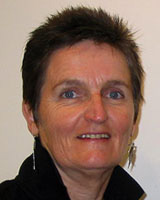Introduction
Providing support and education to remote-area practitioners in Australia via information technology (IT) is a new and emerging field. At the commencement of this research in 2001, there was little published research on its efficacy or feasibility and no national programs specifically targeting remote health practitioners1. In 2003, three Northern Territory (NT) Government sponsored reports, (including a 3 year strategic plan) were released, detailing the challenges of providing remote IT infrastructure2-4. Notable was the NT government's aim to provide broadband telecommunication infrastructure to all remote communities by 20083.
In Australia, rural and remote area nurses have identified difficulties finding information on the internet5. Internationally, these difficulties led to the development of 'navigators': websites and software that guide people to information6. Examples of navigators include search engines such as Google? and databases such as Ebay?. Navigators often have a specialist focus6, such as the Cochrane Collaboration.
There are three factors thought to affect the utility of navigators6. These are: 'reach', the number of people sharing the information; 'agency affiliation', meeting the needs of the target audience; and 'richness', delivering quality, reliable information6. Where agency affiliation and richness are focused on a particular field then reach does not have to be broad, but does need to be specific. These factors were used to develop and evaluate a process that enabled remote practitioners in the NT to access targeted information on maternity care. The researchers believed that a navigator could guide remote-area maternity service providers to a resource library specifically targeting their educational needs.
Discussions with remote practitioners suggested an educational resource library would be valuable if it was easy to access and use. A survey of the Council of Remote Area Nurses of Australia (CRANA) members in 2000 (102 respondents), found 48% required training in IT, with this need increasing with remoteness7. The quality of telecommunications was identified by 74% as affecting their ability to access the internet7. In the same survey, 61% reported having a work-based email account, 44% accessed the internet at work and 57% had internet access at home7. Sixteen per cent had no internet access at all; reasons identified included decisions by management and problems with telephone lines or computers7. With government plans to roll out broadband, it seemed reasonable to investigate the internet as a vehicle for delivering educational support to remote practitioners. Many variables can influence the success of such a strategy and these were to be investigated. They included5:
- telecommunication infrastructure: hardware, speed, reliability, accessibility, cost, support and maintenance
- contextual factors: time available, management constraints, knowledge of its availability
- the human factor: comfort with the technology, education and training, motivation and interest in the resources and technology.
Aim
The aim was to establish and evaluate an internet-based resource library targeting the needs of remote-area maternity service providers.
Research question
What information do remote-area maternity service providers want to access from an internet based resource library and, if this is provided, what are the barriers and facilitators that influence its use?
Methods
A participatory action research (PAR) approach was used for this project with CRANA (a national organisation supporting the remote health workforce) agreeing to host the website. Planning was undertaken with a PAR team and action and evaluation were cyclical as the research team actively contributed to the development of the resource library. A 'navigator' was built and guided practitioners to the resource library which was evaluated against 'reach', 'agency affiliation' and 'richness', with the barriers and facilitators influencing its use described. The research approach is shown (Fig 1).
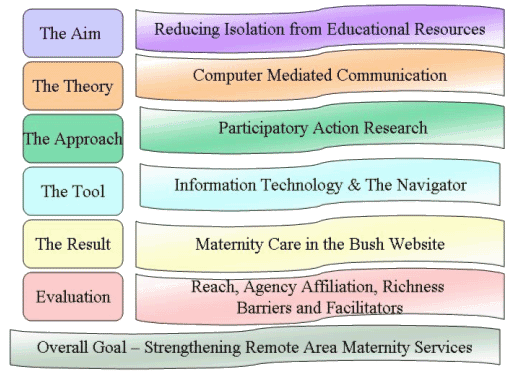
Figure 1: Diagrammatic representation of the research.
Ethics
Ethics approval was granted by the University of Technology, Sydney Ethics Department, the Top End Human Research Ethics Committee in Darwin NT and the Central Australian Human Research Ethics Committee of the NT.
Participants
Defining the target group was important for recruitment and then promotion of the resource library. The target group included maternity service providers involved in the care of women living in remote areas, particularly in the NT. Exact figures for this target group (midwives and doctors with obstetrics training) are uncertain8 with the added complication that registered nurses and Aboriginal health workers, who together make up 95% of the remote workforce9, provide maternity care in some areas. National data shows that there are 305 midwives, 622 medical practitioners (not all have obstetric training) and 12 obstetricians and gynaecologists who provide services to, or live in, remote areas across Australia10-12. In the NT, there are 175 midwives (153 FTE), exact figures for those working in remote are uncertain and dynamic but the majority are known to work in urban and regional areas13. These figures give an estimation of the size of the target group.
A 'letter of invitation' was faxed to all remote community health centres in the NT (n = 52), in June 2002 and placed in newsletters and e-forums. These included: CRANA, Remote Workforce Agency, Central Australian Division of Primary Health Care and the Top End Division of General Practitioners. When individuals expressed interest in being a participant in the research they received a consent form (Fig 2) and an information sheet explaining the project in more detail and giving clear instructions on what was required to participate.
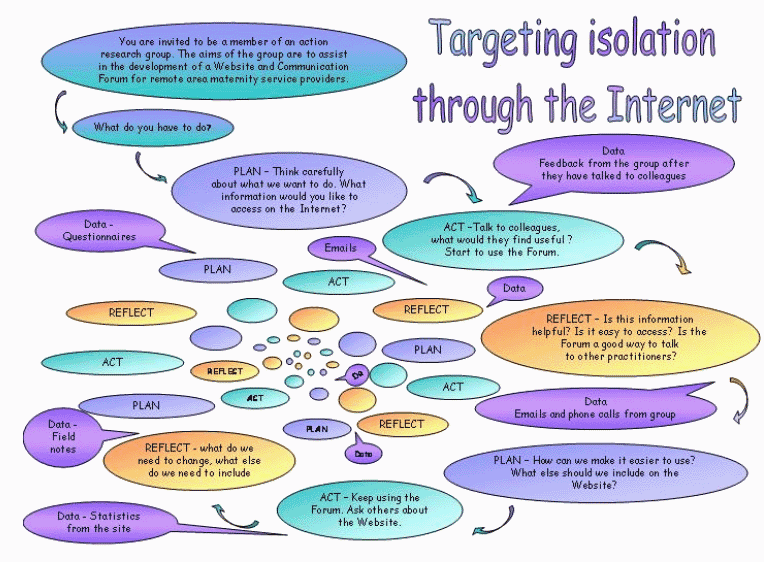
Figure 2: Diagrammatic representation of the PAR approach to be used during the project.
Table 1 shows the professional groups who participated in the research, using Wadsworth's four conceptual parties (a PAR team, a critical reference group [CRG], a group called the 'researched', and the 'stakeholders' group) as a framework for describing participation14.
Table 1: Participants developing and evaluating the resource library
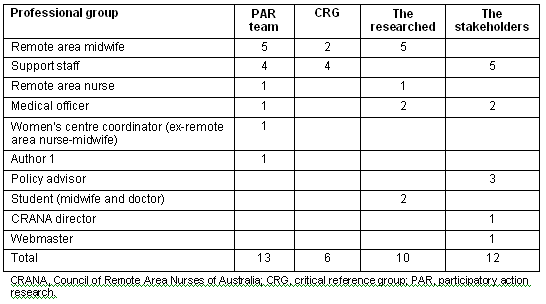
The PAR team was composed of a group of self-selected and targeted midwives and doctors (n = 13) involved in providing remote area maternity services. Many had extensive experience in remote-area women's health service provision. The CRG consisted of practitioners who advised and assisted the project in greater depth (n = 6), all were members of the PAR team. The 'researched' group consisted of remote area practitioners (n = 18) for whom the resource library was being developed. Ten of these participated until the project was completed with a further eight withdrawing during the project due to: moving interstate (n = 4); being unable to get internet access (n = 1); leaving the position (n = 1); partner became ill (n = 1); and, expressed interest but never participated (n = 1). The 'stakeholders' group consisted of those who supported remote maternity service practitioners such as women's health educators (WHE), staff development and orientation personnel and district medical officers.
Data collection and analysis
The resource library was being built simultaneously with a communication forum which was evaluated by the same PAR team and will be reported separately. The Forum was built to be accessible to the PAR team from August 2002 when the team was established. The forum was used to communicate with team members who were talking with other practitioners in the field, and providing guidance for the content of the resource library. Both the forum and the resource library were accessed by a password, given on recruitment. This first phase of the development and evaluation lasted 3 months and involved the PAR team and webmaster only. The PAR team identified the information and materials they believed would be helpful in the library together with the barriers and facilitators to internet access. Data were taken directly from the forum, email and phone contact. The ongoing evaluation, reflection and then further planning and action did not always occur in the cyclical order described in the literature,15 but opportunistically, responsively and rapidly. Most of the changes suggested by the research participants were incorporated into the website as they were recommended. Ongoing literature searches and internet browsing was performed to search for resources and links that would be appropriate for the site. The researcher had planned for fortnightly review by team members during this stage; however, as explained in the Results section, review was erratic and slower than anticipated.
Phase two of the research occurred from November 2002 to November 2003 and involved all research participants. During this time a questionnaire was completed by seven of the PAR team members with a further four answering the questions on email and one member discussed the questionnaire by phone. The CRG participated in phone interviews of up to one hour's duration. They identified factors affecting the use of the resource library and provided feedback on content, ease of use and navigation. The forum was not used by the research participants as much as had been anticipated with 27 research participants commenting via email, many multiple times. Additional data were gathered from: the webmaster; direct feedback from the website (a comments section had been added); and direct feedback (usually by email) from other interested parties who were accessing the site. The following email is an example of some that were received:
I'm after some info - what was the name of that report on birthing in the Top End, Aboriginal women's experiences of birth and birth options? I'm writing an essay for the Remote Health Practice course and would like to try and get it. (Remote Area Nurse Midwife [RANM], 07.03)
In response, the report was placed on the website in PDF format, under the section entitled 'Reports of Interest'.
Statistics were collected on the number of 'hits' to the resource library. All email (n = 166), questionnaires and field notes were imported into a qualitative analysis software program (ATLASti: ATLAS.ti Scientific Software Development GmbH; http://www.atlasti.com), for data storage, management and retrieval. Descriptive analyses were undertaken with major themes that emerged from the data described and categorised.
Results
The resource library, hosted on the CRANA website, went 'live' in November 2002 (www.crana.org.au - maternity care in the bush). The information was catalogued under separate sections: Clinical-Courses, Clinical-Antenatal, Clinical-Birth and Postnatal, Guidelines, Reports of Interest, Articles of Interest, Resources for Parents, Online Journal Links, Web Sites of Interest and Women's Health. Each of the above sections contained articles, reports, reference material and links to other websites. Promotion of the resource library occurred simultaneously with information placed in journals, newsletters and e-forums (n = 32) aimed at the target group. Fliers were distributed at conferences where presentations (n = 6) were also given. Many organisations listed on the resource library placed a reciprocal link to the resource library on their own website.
Reach
The number of 'hits' to the site received over the study ranged from 62-222 per month with a mean of 134 hits per month. Measured again in January 2005, the website statistics showed the number of 'hits' averaged 100 per month.
Agency affiliation
The cyclical PAR approach ensured the research group influenced the composition of the resource library increasing agency affiliation as the project progressed. An example of feedback around agency affiliation included the following email: 'Some of the remote workers have said they would like clinical information - updates on new drugs for preterm labour etc' (WHE, 05.03). In response, two clinical sections were placed on the site, one for antenatal care and one for birth and postnatal care, with a focus on the issues that are particularly pertinent in remote Australia (eg preterm labour). Table 2 is an example of how agency affiliation worked.
Table 2: Reflection and action used to improve agency affiliation
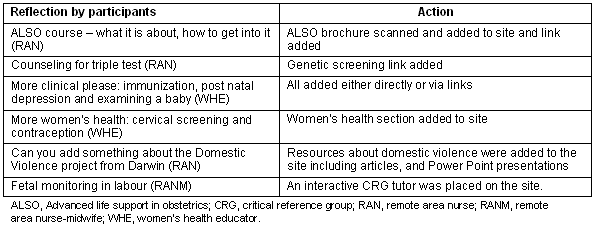
Richness
Richness involves delivering relevant information, including reliability, security and bandwidth6. Again, the PAR process assisted with this, although some factors were beyond the control of the research: for example, bandwidth. Most of the comments received indicated that the target audience felt the information provided was: 'Contemporary, relevant reports and articles, which are quick and easy to access' (Remote Area Nurse [RAN], 03.03). Feedback included statements such as: 'Women's health site is great for checking on management options out bush' (RAN, 03.03) and:
Have just visited the above site and it's great. Am looking forward to spending more time with the links. Last year I completed my Masters of Public Health... I am very interested in cultural safety issues. Is it possible to get more info at this stage? (RAN, 03.03)
Practitioners in leadership and education positions identified the site as a valuable resource enabling access to professional knowledge which could be further distributed to the remote based practitioners:
I utilise the site prior to facilitating courses, for updated information, and if an inquiry comes from a RAN about a particular subject. I can either send the link or print it and send by snail mail. The links are good if I need to extend my search. It is on my 'favorites' list. (WHE, 08.03)
Thus, even if the remote practitioners did not have internet access they were still able to access the material, through the regional support positions.
In contrast, some thought the site was 'a bit boring' visually. '... I hate the white spaces on the web, the front page is boring and needs to be more interesting, also you need road signs to know where to go' (WHE, 11.02). Initially, lack of visually appealing graphics was intentional to hasten access, as use of high quality graphics affect opening and download speeds. Speed is thought to be an essential component of a usable website with 15 seconds recommended as a general guide for download times16. Some of the participants were using standard phone lines for internet access, resulting in very slow download speeds. Many of the documents on the library required PDF format which remained a problem for many users: '...the PDF files are very slow to download' (RANM, 07.02). However, based on feedback, changes were made to improve the visual appearance of the site without markedly compromising speed. Other comments relating to richness included: 'Very user friendly' (RAN, 05.03).
Internet access
Access issues are grouped under the headings: Telecommunications Infrastructure, Contextual Factors, and Human Factors5.
Telecommunications infrastructure: Initially, most remote practitioners cited inadequate computer hardware. Nonetheless, IT provision was dynamic with improvements occurring during the research. Initially, one member of the research group did not have access when travelling in remote areas; however, by November 2003, she emailed that: '...the remote Health Centres here have just got computers with internet access' (WHE, 11.03). Other responses were less positive. For example, one remote community had been paying the lease on computers for 2 years but they had remained in their boxes. Staff unfamiliar with the technology had shown no interest in setting up the computers and had not been supported to do so. Some health centres had computers but no satellite dish, and others had satellites delivered but not installed: 'We've had the satellite dish on the roof for ages but it doesn't work yet' (RANM, 04.03). Other reasons included buildings that were not strong enough to hold the satellites and trees needing to be cut down. These extra costs had not been budgeted for, and respondents claimed no-one was prepared to pay for these unforeseen requirements. A lack of coordination between the organisation responsible for rolling out the technology and its recipients was described.
Lack of internet access was a commonly identified barrier: '...only the Director of Nursing and medical students have access' (rural midwife, 11.02); '[I have] no internet access at work where I need this information, not a fault of the website' (rural midwife, 11.02). (This situation was unchanged in 2006 when the author visited the hospital referred to). Of the 166 emails from the research participants, only two had very positive responses regarding unlimited internet access: 'I'm in a one-nurse post and I love the internet, it has transformed my life' (RAN, 10.02). Internet access was available in the homes of 77% of the PAR team, in the workplace for 53%, and 31% had access via both. These figures are slightly increased from those reported in the CRANA survey in 20007.
Contextual factors: Time to learn about, or use, the internet was a barrier noted by many of the research participants, for example: 'I have accessed it but not had time to look at it properly' (RAN, 05.03). Discussions with managers and policy officers confirmed cost and management concerns were common: '...at $18 per month per staff member with a 50 MB download it can get very expensive ... sharing logon access ... no good - if someone gets onto pornographic sites you can't track who it was' (policy officer, field notes, 05.03); 'I can't give access to any of my staff... the directive comes from Darwin' (rural DON, field notes, 03.03). 'The personal cost incurred through accessing the internet and experiencing technical difficulties was also identified as a barrier: ...My phone bill has gone up by $60 a month because of line dropouts' (RAN, 09.02).
Technical difficulties included corrupted files and old operating systems that had difficulties viewing the site. Although usually repaired fairly easily and quickly, when practitioners are busy and not particularly familiar with computers, these inconveniences can affect the utility of the resource. This was particularly so in the remote setting but also problematic for people in regional areas, highlighting the need for telephone support. Further discussions with the research group highlighted the need for a search engine on the site. One was installed and required more precise descriptions with key words that the target audience would use when searching for information.
Human factors: 'Hardware' is not all that is needed to utilise such resources. Individuals must have the time, motivation and skills with troubleshooting support available when required6,17. These issues were of concern to many of the research participants in this study, for example: 'Many practitioners say they have no time to deal with computers' (IT policy officer, field notes, 11.03). Some of the participants had very little experience with computers, affecting their interest and ability to access the site: 'I felt a little perplexed by it - no idea what cookies etc are - so I guess I need some coaching, preferably on the phone or in person' (RAN, 11.03). Although anecdotal evidence had suggested this situation was improving, a significant barrier was the lack of computer support in remote areas with not one of the remote participants having on-site support. 'We've had no support or training' (RANM, 11.03). When problems were identified there were significant challenges in rectifying them: 'Viruses are a problem with no budget for flying people out to assist. We tried to send out a disc for fixing the computers but people couldn't access it (IT policy officer, field notes, 8.03). These results are consistent with a 2003 report that identified an almost complete lack of onsite assistance to operate, repair, maintain and service telecommunications across remote communities, including those with extensive infrastructure in place from recent Commonwealth Government initiatives3.
Limitations of the research
One of the limitations of this research was the inability to identify if the hits to the site were from the target group. The only way to get a precise estimation of this would have been too ask this question prior to entry. Given the barriers and difficulties experienced by the research participants, evident early in the research, a decision was made not to do this. Another limitation was the lack of clear data quantifying the number of research participants who had the appropriate technology for computer mediated communication in their homes or at the workplace. The questionnaire had not been specific enough to provide this data and was only completed by the PAR team. This information would have been more helpful had it been collected from all research participants, although this has recently been researched (2005) in a national project with the final report due to be released in 200618.
Discussion
Maintenance of professional competence is a key area of concern for health providers in remote areas who experience difficulty in accessing current research, guidelines and educational updates19-20. Barriers to providing education for remote practitioners are many, including the expense involved in travelling for education being prohibitive, and relief staff often unavailable. At the commencement of this research there was little known about the viability of providing education and training to remote practitioners via IT. This research has provided information in this area. Overall, the evaluation of the resource library was very positive. Practitioners in leadership and education positions identified it as a valuable resource enabling them to access professional knowledge, which could then be distributed to the remote based practitioners, who experienced difficulties with access themselves. Issues of access are still a major problem for potential users, despite anecdotal evidence suggesting recent improvements in remote telecommunications, and Commonwealth Government initiatives targeting remote communications21.
Using PAR and involving the remote practitioners directly proved to be effective, as the agency affiliation of the resource was greatly strengthened through this approach. Feedback from the PAR team described the resource as contemporary, useful and relevant with one participant suggesting it was essential. The 'navigator' evaluation framework of reach, agency affiliation and richness, most often used in the business world, was also helpful in this setting.
One of the research objectives was to identify the facilitators and barriers to accessing resources via the internet. Telecommunications infrastructure, contextual factors and the identified human factors all need better resourcing for the internet to achieve its potential in this setting. Hardware inadequacies, access difficulties, the lack of management support for staff to utilise the resource, and not being familiar with computers were all identified barriers. In some health centres, access and log-in decisions were made by the local manager, yet in other areas staff had been told the decisions were policy directives from the NT Department of Health and Community Services. The lack of management support was also an identified barrier in the CRANA survey conducted in 20007. This evaluation highlighted difficulties in determining who was ultimately responsible when technical or structural barriers prevented the hardware from working. This situation seemed to be exacerbated in a climate where the NT government is moving towards Aboriginal control of health services.
Some communities had received telecommunication grants to provide satellites, sophisticated hardware and software. However, there is little funding for the education and training of staff in the use of equipment, or to assist in the transfer of existing health data onto new computer systems3. Busy practitioners unfamiliar with computers reported technical difficulties including corrupted files and problems with operating systems that affected the utility of the resource. This was particularly so in the remote setting, but was also problematic for people in regional areas, highlighting the need for telephone support. The additional costs involved in providing support to geographically distant areas should be an added impetus for a whole-of-government approach, however there is little evidence in the literature3 or from the present research of this occurring.
The evaluation found a significant number of remote area practitioners need education and training in IT. This situation has not changed significantly since the survey of CRANA members in 2000 which showed 48% required training in IT with only 4% receiving professional training in this field in the previous 12 months7. The pivotal question of whose responsibility it is to provide the education and training is yet to be resolved. Whether this resides with the individual health worker, the employers, or the State, Territory and Federal governments, must be addressed before the full effectiveness of computer mediated communication can be realised. In some instances, education and training would have to commence at a basic level and 24-hour phone support service would be advantageous. The barriers and facilitators that impacted on the development and utility of this strategy need to be addressed as a matter of urgency.
The resource library in 2006
Since being established, the resource library has become a core component of the CRANA website. The resource library was updated with the website in late 2005. At this time, CRANA decided to expand the site offering more resources to those who access it. CRANA office staff have been trained to update the website and the resource library and are responsible for checking the links are still active. Users who find broken links are encouraged to notify CRANA via a 'broken links' section with the most recent message received in early 2006. Members of CRANA are encouraged to forward any material that may be appropriate, and this is added to the resource library.
Acknowledgements
This work was partly funded by a Rural Health Support, Education and Training Grant from the Commonwealth Government. We would like to thank the research participants for their contributions. Author Sue Kildea is the Vice President of the Council of Remote Area Nurses of Australia.
References
1. National Health Information Management Advisory Council. Health online: a health information action plan for Australia, 2nd edn. Canberra: Commonwealth of Australia; 2001.
2. Peter Farr Consultants Australasia. Connecting our communities, sustainable networking strategies for Australian remote Indigenous communities. Canberra: DCITA, 2003.
3. Northern Australia Business Services, Ganter Consulting Services, Focus Pty Ltd. Remote community information and communications technology solutions. Darwin: DCIS, Northern Territory Government, 2003.
4. Northern Territory Government. Remote areas telecommunications strategy, 2003-2008, building a connected Territory. Darwin: Northern Territory Government, 2003.
5. Project for Rural Health Communications and Information Technologies. Telehealth in rural and remote Australia, Report of the Project for Rural Health Communications and Information Technologies (PRHCIT). Monash University: Australian Rural Health Research Institute, 1996.
6. Evans P, Wurster T. Blown to bits, how the new economics of information transforms strategy. Boston: Harvard Business School Press, 2000.
7. MI Taylord Services. CRANA Member Survey 2000. Alice Springs: Council of Remote Area Nurses of Australia, 2000.
8. Tracy S, Barclay L, Brodie P. Contemporary issues in the workforce and education of Australian midwives. Australian Health Review 2000; 23(4): 78-88.
9. Council of Remote Area Nurses of Australia. About CRANA. (Online) 2004. http://www.crana.org.au (Accessed: 22 February 2004).
10. AIHW. Nursing labour force 2002. Canberra: Australian Institute of Health and Welfare, 2003.
11. AIHW. Medical labour force 2001. Canberra: Australian Institute of Health and Welfare, 2003.
12. AIHW. Health in rural and remote Australia. Canberra: Australian Institute of Health and Welfare, 1998.
13. Australian Health Workforce Advisory Committee. The midwifery workforce in Australia 2002-2012 (AHWAC Report 2002.2). Sydney: Australian Health Workforce Advisory Committee, 2002.
14. Wadsworth Y. What is Participatory Action Research? (Online) 2002. Available: http://www.scu.edu.au/schools/gcm/ar/ari/p-ywadsworth98.html (Accessed: 16 June 2006).
15. Kemmis S, McTaggart R. Participatory Action Research. In: N Denzin, Y Lincoln (Eds). Handbook of Qualitative Research. London: Sage, 2000.
16. Preece J. Online communities: designing usability, supporting sociability. Chichester: John Wiley and Sons, 2001.
17. Norris P. Digital divide?: Civic engagement, information poverty, and the internet worldwide. Cambridge: Cambridge University Press, 2001.
18. ANF. Nurses and information technology: An Australian Nursing Federation project funded by the Australian Government. (E-bulletin) 2 May 2005. http://www.anf.org.au/it_project/e_bulletin2.pdf (Accessed: 25 May 2005).
19. NRHA. National Rural Health Alliance submission to Senate Community Affairs References Committee, inquiry into nursing. Canberra: National Rural Health Alliance Inc, 2001.
20. Department of Health and Aged Care. Rethinking nursing, National Nursing Workforce Forum. Canberra: Commonwealth Department of Health and Aged Care, 1999.
21. Department of Communications Information Technology and the Arts. Telecommunications action plan for remote Indigenous communities. Canberra: Department of Communications Information Technology and the Arts, 2002.


